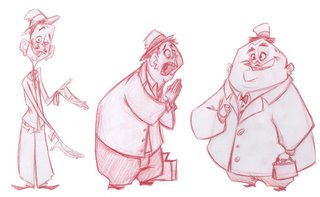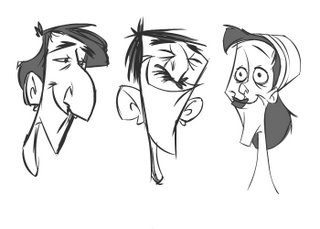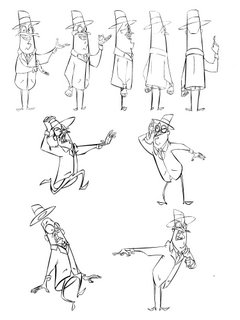KYLE MARSHALL INTERVIEW
Designer and Animator
Friday, May 19, 2006
BROUGHT TO YOU BY THE CHARACTER DESIGN BLOGSPOT
THE INTERVIEW

Tell me a little bit about yourself, about your life? Where did you go to school, and what classes did you study? What helped prepare you to become the artist that you are today?
I was born in the small farming community of
But it really taught us to work hard, and to never stop trying to improve. It also created that completive edge you needed at 3 am, when your drawing away with no end in sight. We also had some absolutely amazing instructors, James Clow, Gord Groat, Bob Bowen and Tetyana Gershuni. S.C.E.TCH. had to eventually close its doors after my second year, and two of our instructors, Gord and James, Started up a new school (Redhouse College) which my 5 fellow classmates and I Graduated from. These two guys were the most dedicated instructors I think any student could ask for, and they never stopped pushing us.
How do you go about designing a character, and what goes through your mind, from start to end?
I guess that depends on what I am designing for. Basically, If I am working on a project and trying to flush out the many traits, and qualities of a character, I will just draw like mad, scribbling many different shapes and combinations of features until I start to see a story within the character that fits my needs. I Then begin building off that and trying a few different ways of going about that character, am I going to have just one steady line from the butt to the ankle or am I going to define the muscles, How big are those eyes in comparison to the mass of the skull, what works best for the story I am trying to tell, and how does that fit with any characters I have already created for the project? Another big thing I will do before I nail down anything on the character, is to test the design in different poses, and work out expressions to see how different features will or won't play off of one another in a variety of extremes. I really like to flip through the different designs, almost like I am working from pose to pose, trying to eye up where things are "popping" or deviating from the design I am shooting for.
What do you think really helps you out in designing a character?
Large, medium, small. Strong Silhouette with L, M, S in the negative space. Playing with thirds, keeping a large portion of the features in the design in the top or bottom third of the face, etc. Straights and curves are always fun to play around with, and of course shapes. But depending on the design, I may not really push these ideas. Also, refreshing your brain with new inspiration, whether it be from life, or some artist who has been doing work way out in left field compared to what you are used to. Most of all, just trying to capture the emotion that describes this character best. Shamefully, there are times I forget all tips like L, M, S, strong silhouette, thirds, etc. I then look at my drawing, and find myself crying.
From your own experience and maybe from some people that you know, what should we put in our portfolio and what should we not?
I have only been out of college for about a year and a half now, and my portfolio has been shutdown by many studios, so I don't know if I am one to advise others what to put in their portfolio. But, I agree with everything that has been said by all the other artists at this point. What I do want to say though, which has to do with getting work, but not specifically your portfolio, is to get your name out there. Use every form of exposure you can. The internet is a crazy tool, and if you are just trying to break into the industry, use this tool. Get a blog, get a website, visit forums. It can sometimes take up allot of your time, but it is well worth it. Advertise yourself a bit by just visiting other artists blogs or sites. Just get your name out there, more people that know you exist, the better.
Also, for the students, your friends and connections you make in school can at times be just important as your classes. Don't hide in a corner with your sketch book, make friends, go drawing with classmates, have classmates critique your work, and a little competition is good but always be there to help others out. If you have just discovered line of action and you know the rest of your design class is having troubles, help others find that line, and someday when you need a little hand they will be there to share their breakthrough. I have already found how important the friends I made in school have become when I was out looking for work.
What are some of the things that you have worked on?
I am currently working at Trapeze animation in
My first job out of school was on a crappy little straight to video 2D feature. I was able to do everything on it from storyboards, to key animation. The experience was really the only thing I could take from that project, as you won't find anything from it on my demo or portfolio.
I have also done a bit of freelancing, doing boards and rough animation for a music video, and some small website work.
Is there a character design you have done that you are most proud of?
Nah, my drawings are not that precious. Maybe in 50 years I can look back and be proud of a foot, or an eye socket on a character, But I usually draw something, like how it looks at midnight, wake up the next morning, crumple up the paper and bang my head against the wall for thinking it was a good drawing.
What are you working on now? (If you can tell us)
I don't really know how much I can say about what we do at Trapeze, mostly development work at the moment. In my own time, freelancing gigs are always nice. My big time killer lately, has been a new animated short I started working on a few months ago. I realize for the next few years the only way to get the stories I want to tell on screen, will be to sit down and do them in my own time. I am hoping it will be completed in about a year and a half from now, but who knows what could happen within that time. I have posted a few concept drawings on my blog and I will continue to show bits and pieces as it progresses.
Where is the place you would like to work if you had a choice?
Everyone says Pixar, and yea, that would be great, but I will wait a few years before applying there. I have allot of bad drawings to get out of my system first. At the moment, I am a big fan of the small studio environment. I get to know my co workers a bit more, and I get to put my fingers on a bit of everything. I guess if I had to name a studio, House of Cool looks like an ideal place.
Who do you think are the top character designers out there?
This has become very cliché to say, but there are just to many to mention. I would have to say my biggest influence over the past few years has been Robin Mitchell. He is a very solid draftsman, and his characters have so much personality. I love the shapes and features that guy comes up with. Then of course John Nevarez, I don't think I have seen many drawings that are as fun to look at, as his.
Then there are amazing talents such as: Chuck Jones, Sylvain Chomet, Uli Meyer, Teddy Newton, Tony Fucile, John K, Ralph Bakshi, Shane Glines, Mary Blair, Bruce Tim, Harold Sieperman, Peter De Seve, Buck Lewis, Peter Clarke, Jasen Strong, Hans Bacher, Marco Allard, Pat Smith, Don Hertzfeld, Rodolphe Guendon, Nick Cross, Martin Wittig, Bobby Chiu,
How do you go about coloring the character, what type of tools or media do you use?
I don't use allot of color, but when I do, I like things simple. I am a big fan of the old UPA cartoons. So, for color I just use Photoshop or lately it has been Macromedia Flash.
What part of designing a character is most fun and easy, and what is most hard?
Nothing ever comes easy, but the funniest thing would have to be the faces and expressions. I love just scribbling and creating different shapes and trying to fit features into those shapes. The hardest would have to be caricatures and anatomy, the two things I am still struggling with the most.
What are some of your favorite character designs and least favorite, which you have seen?
Like I said before, I love old UPA. All of those designs, whether it be the layouts or the characters themselves, are just amazing. Big fan of Chuck Jones's Daffy, Incredible posing. The triplets, and the mafia men from Triplets of Belleville are some of my favorites, really that entire film is just a goldmine of design. I would have loved to be on the animation team for Kronk, everything from his design to who the character was. He goes down as one of my all time favorite animated characters.
What is your most favorite subject to draw? And why?
Really stupid ugly people. I just love drawing stupid characters, and trying to make people laugh from just a little drawing. I guess that is the one thing I would really want to be known for someday, is my style of drawing really stupid ugly people. Wow, I have high hopes for myself!
What inspired you to become an Artist?
It first started in high school. I watched two films, American History X, and He Got Game, and for some weird reason it just clicked, I wanted to make films, although at that time I didn't think it was going to be animation. Once I was in college, it was films like Iron Giant, Drip-Along Daffy, Deduce You Say, and Rabbit Seasoning that really pulled me into animation. I guess after understanding more about what made the comedy behind old Warner Cartoons, I found myself wanting to use animation as the medium to cause that pain in one's stomach they receive after laughing uncontrollably.
What are some of the neat things you have learned from other artists that you have worked with or seen?
Again, to many neat things. But like John Nevarez said, one thing above all, is keeping it loose.
What wisdom could you give us, about being an Artist? Do you have any tips you could give?
Never stop drawing. Draw constantly, get rid of the 40 inch TV, Drop that philosophy class, sell that orange pinto in your driveway, free up some time to draw, and ride the bus. Sketch all those crazy cats riding the public transit with you, or that man in the corner of the Cafe, who is transfixed in a delightful conversation with himself. This is just my opinion, but draw other artists characters as well, that's how I learnt. Understand what makes their work so appealing by drawing from it. And, always ask for outside opinions. I find myself constantly getting to involved with an arm or a line in the back, and have completely forgot that the characters centre of gravity is way off. But as soon as I show someone else my greatest achievement ever, they quickly point out that huge glaring problem with the
character, or usually the ten glaring problems.
If people would like to contact you, how would you like to be contacted?
You can contact me at my email: milly4monkeys@hotmail.com Or you can just pop over to my blog at www.kylemarshall.blogspot.com. I guess I am a bit of a hypocrite, as I preached about getting yourself out there with a website. My website is hardly working at the moment, so no need even mentioning that address.
Finally, do you have any of your art work for sale (sketchbook, prints, or anything) for people that like your work can know where and when to buy it?
No, I have zilch for sale, but If anyone happens to want a commission or has any freelance invitations, I would be happy to hear about them all.























